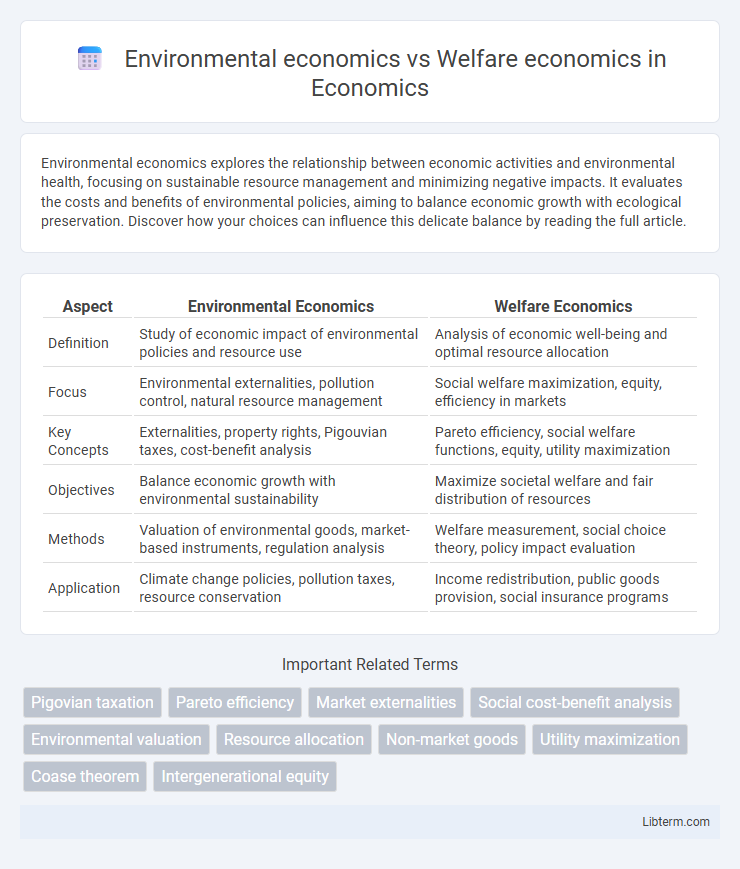Environmental economics explores the relationship between economic activities and environmental health, focusing on sustainable resource management and minimizing negative impacts. It evaluates the costs and benefits of environmental policies, aiming to balance economic growth with ecological preservation. Discover how your choices can influence this delicate balance by reading the full article.
Table of Comparison
| Aspect | Environmental Economics | Welfare Economics |
|---|---|---|
| Definition | Study of economic impact of environmental policies and resource use | Analysis of economic well-being and optimal resource allocation |
| Focus | Environmental externalities, pollution control, natural resource management | Social welfare maximization, equity, efficiency in markets |
| Key Concepts | Externalities, property rights, Pigouvian taxes, cost-benefit analysis | Pareto efficiency, social welfare functions, equity, utility maximization |
| Objectives | Balance economic growth with environmental sustainability | Maximize societal welfare and fair distribution of resources |
| Methods | Valuation of environmental goods, market-based instruments, regulation analysis | Welfare measurement, social choice theory, policy impact evaluation |
| Application | Climate change policies, pollution taxes, resource conservation | Income redistribution, public goods provision, social insurance programs |
Introduction to Environmental Economics and Welfare Economics
Environmental economics examines the economic impacts of environmental policies and the efficient allocation of natural resources to address issues like pollution and climate change. Welfare economics focuses on the overall well-being and allocation of resources to maximize social welfare and equity among individuals in an economy. Both fields integrate economic theory to evaluate trade-offs between resource use, economic efficiency, and societal welfare, but environmental economics emphasizes sustainability and ecological constraints.
Core Concepts and Theoretical Foundations
Environmental economics centers on the efficient allocation of natural resources and the internalization of externalities to address market failures caused by pollution and resource depletion. Welfare economics focuses on evaluating economic policies based on their impact on social welfare, using concepts like Pareto efficiency and social welfare functions to assess redistribution and utility maximization. Both fields share a foundation in microeconomic theory but diverge in emphasis, with environmental economics prioritizing ecological sustainability and welfare economics emphasizing equitable resource distribution.
Defining Welfare: Economic Growth vs Social Well-Being
Environmental economics emphasizes sustainable economic growth by integrating natural resource management and environmental costs into market systems, highlighting economic growth's impact on long-term welfare. Welfare economics prioritizes social well-being by evaluating income distribution, utility, and societal equity, focusing on maximizing collective happiness rather than mere GDP growth. The core distinction lies in environmental economics balancing economic expansion with environmental preservation, while welfare economics centers on optimizing social welfare outcomes irrespective of growth metrics.
Environmental Externalities and Market Failures
Environmental economics examines the impact of environmental externalities, such as pollution and resource depletion, on market efficiency and social welfare, highlighting how these negative externalities lead to market failures. Welfare economics analyzes overall economic well-being and the allocation of resources, emphasizing the need for government intervention through policies like taxes or subsidies to correct inefficiencies caused by externalities. Both fields address market failures but with different emphasis: environmental economics targets sustainable resource management, while welfare economics focuses on optimizing social welfare outcomes.
Policy Instruments: Taxes, Subsidies, and Regulation
Environmental economics emphasizes policy instruments such as Pigouvian taxes to correct externalities, subsidies to promote sustainable practices, and regulatory measures like emission standards to mitigate environmental harm. Welfare economics assesses these tools based on their ability to enhance social welfare, focusing on efficiency and distributive equity in resource allocation. Both disciplines analyze the impact of taxes, subsidies, and regulations, but environmental economics prioritizes ecological outcomes while welfare economics centers on maximizing overall societal well-being.
Measuring Environmental Impact on Welfare
Environmental economics quantifies the costs and benefits of environmental changes using tools like cost-benefit analysis and ecosystem service valuation to measure impacts on societal welfare. Welfare economics evaluates how changes in resource allocation affect overall social welfare, often employing utility functions and social welfare functions to assess equity and efficiency. Integrating environmental impact metrics into welfare economics allows policymakers to optimize resource use while promoting sustainable well-being.
Cost-Benefit Analysis in Environmental Decision-Making
Environmental economics specializes in evaluating ecological costs and benefits, emphasizing sustainable resource use and pollution control through Cost-Benefit Analysis (CBA). Welfare economics focuses on maximizing social well-being, using CBA to assess the impact of environmental policies on overall social welfare and distributional effects. Integrating both approaches, CBA in environmental decision-making quantifies economic, ecological, and social outcomes to inform policies balancing efficiency and equity.
Sustainable Development: Bridging Economics and Welfare
Environmental economics examines the allocation of natural resources and the impact of economic activities on ecosystems, emphasizing cost-benefit analysis to promote sustainability. Welfare economics focuses on the well-being and utility of individuals, aiming to maximize social welfare through equitable resource distribution. Integrating these fields supports sustainable development by balancing ecological preservation with social equity, ensuring long-term economic growth and improved quality of life.
Challenges in Valuing Environmental Goods and Services
Environmental economics faces challenges in valuing non-market goods like clean air and biodiversity, as these lack explicit prices and require methods such as contingent valuation and hedonic pricing to estimate their economic worth. Welfare economics grapples with measuring social welfare changes, especially when environmental externalities affect well-being but are not reflected in market transactions. Both fields confront difficulties incorporating intangible benefits, intergenerational equity, and uncertainty into economic valuations, complicating policy design and resource allocation.
Future Directions: Integrating Environmental and Welfare Economics
Future directions in environmental and welfare economics emphasize creating integrated models that quantify ecosystem services alongside human well-being metrics. Progress in computational tools and big data analytics enables comprehensive assessments of policy impacts on both environmental sustainability and social equity. This integration supports adaptive governance frameworks that reconcile resource allocation with long-term ecological resilience and poverty alleviation goals.
Environmental economics Infographic

 libterm.com
libterm.com